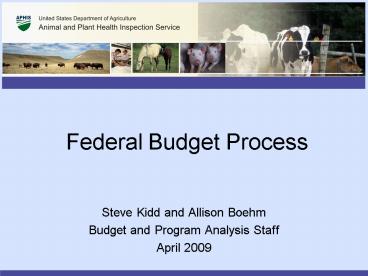Federal Budget Process PowerPoint PPT Presentation
1 / 28
Title: Federal Budget Process
1
Federal Budget Process
- Steve Kidd and Allison Boehm
- Budget and Program Analysis Staff
- April 2009
2
(No Transcript)
3
(No Transcript)
4
(No Transcript)
5
(No Transcript)
6
Constitutional Law
- Article 1, Section 9 of the U.S. Constitution
- No money shall be drawn from the Treasury, but
in Consequence of Appropriations made by Law and
a regular Statement and Account of the Receipts
and Expenditures of all public Money shall be
published from time to time.
7
Purpose of the Budget
- Request permission to spend government funds.
- Control spending to an approved level.
- Establish accountability.
- Analyze performance plans.
8
Federal Budget Process - Three Stages
- Budget Formulation creation of the Presidents
Budget. - Budget Justification presenting and justifying
the Budget to Congress. - Budget Execution spending funds in accordance
with Congressional intent.
9
Budget Process Timeline
- Budget Formulation
- 2 years prior
- Budget Justification
- 1 year prior
- Budget Execution
- Current year
It takes 2 years to get an appropriation!
10
Phase 1 Budget Formulation
- President
- Sets policy through the Office of Management and
Budget (OMB). - Department of Agriculture
- Sets priorities through strategic plan.
- APHIS
- Also sets strategic priorities.
11
Formulation Overview
- Program Planning and Budgeting
- Starts in March each year.
- Agency Request
- Due to the Department in early July.
- Departmental Feedback
- Received in late summer.
- OMB Allowance
- Received in late November/early December.
- Presidents Budget
- Due to Congress the first Monday of February.
12
USDA/OMB Concerns
- What is the problem the request is trying to fix?
- What is the Federal governments role in fixing
the problem? - What is the impact of the increase on
performance? - Are alternative proposals more effective?
- What are cooperators doing to help us achieve the
goals? - What is the economic value of the effort?
13
Presidents Budget
- By law, the Budget is submitted to Congress the
first Monday in February. - APHIS submits supporting material along with all
USDA agencies Explanatory Notes. - Justification begins.
14
Phase 2 Justification
APHIS prepares materials to defend the
Presidents Budget.
15
Congressional Appropriations Structure
House Senate Committees
House
Senate
Committee on Appropriations 13 Subcommittees
Committee on Appropriations 13
Subcommittees
Agriculture, Rural Development, Food Drug
Administration, Related Agencies.
Agriculture, Rural Development, Related
Agencies
16
Phase 2 Justification
- House and Senate Appropriations Sub-Committees
hold hearings. - APHIS answers Questions for the Record.
- APHIS received more than 300 questions last year.
17
What is Congress interested in?
- Spending in individual members States.
- Funds provided to individual members States
(through cooperative agreements). - How do we get the information?
- Geographic Report (provided by APHIS programs
with input from Agreements Specialists).
18
Conference?
House Floor
Senate Floor
Full Approps. Committee
Full Approps. Committee
Sub-Committee on Agriculture
Sub-Committee on Agriculture
19
President Signs the Agriculture Appropriations
Bill into law.
20
If the Bills not signed by Oct. 1.
- Continuing Resolution
- Interim appropriation.
- Sets funding at the prior year level.
- Gets extended until an appropriation act takes
its place.
21
Phase 3 Execution
- APHIS gets an appropriation.
- Apportionment Process (OMB officially transfers
funds to USDA/APHIS). - Allocation Process (Agency gives programs
authority to spend funds).
22
Phase 3 Execution, cont.
- Those of us who manage the publics dollars will
be held to account--to spend wisely, reform bad
habits, and do our business in the light of day - --President Obama
23
APHIS Cooperative Agreements
- In FY 2008, APHIS had approximately 1.2 billion
in budget authority from all funding sources. - 47 percent of spending in FY 2008 was for
salaries and benefits. - APHIS obligated over 217 (or about 18 percent)
million of its FY 2008 budget for cooperative
agreements.
24
Recent Audit Finding
- A recent audit of USDA indicated a material
weakness. - High unliquidated balances of obligations.
- A Secretary Priority.
- Each USDA Agency Administrator is held
accountable for ensuring low levels of
unliquidated balances.
25
Audit Finding Impact
- A significant portion of APHIS discretionary
spending is cooperative agreements. - Considerable number of obligations from prior
years remain unliquidated. - Unliquidated obligations in cooperative
agreements for prior years may impact future
funding decisions. - Increased need for cooperators to submit requests
for payment in a timely manner.
26
Budget Outlook and Affect
- Current outlook is for flat budget.
- APHIS will look to stretch resources.
- Look to effective spending.
- Timely reporting and billing.
27
FY 2009 Omnibus
- The FY 2009 Omnibus provides 877 million for
APHIS salaries and expenses.
FY 2010 Presidents Budget
- The FY 2010 request for APHIS salaries and
expenses is 872 million.
28
Questions?

